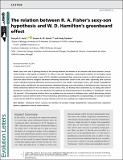Files in this item
The relation between R. A. Fisher’s sexy-son hypothesis and W. D. Hamilton’s greenbeard effect
Item metadata
| dc.contributor.author | Faria, Goncalo | |
| dc.contributor.author | Varela, Susana | |
| dc.contributor.author | Gardner, Andy | |
| dc.date.accessioned | 2018-05-04T14:30:13Z | |
| dc.date.available | 2018-05-04T14:30:13Z | |
| dc.date.issued | 2018-05-03 | |
| dc.identifier | 252772014 | |
| dc.identifier | f715fdbc-2db4-4f34-a282-1aff5b47c6ac | |
| dc.identifier | 000446766800005 | |
| dc.identifier | 85066245580 | |
| dc.identifier.citation | Faria , G , Varela , S & Gardner , A 2018 , ' The relation between R. A. Fisher’s sexy-son hypothesis and W. D. Hamilton’s greenbeard effect ' , Evolution Letters , vol. Early View . https://doi.org/10.1002/evl3.53 | en |
| dc.identifier.issn | 2056-3744 | |
| dc.identifier.other | ORCID: /0000-0002-1511-8680/work/44362062 | |
| dc.identifier.uri | https://hdl.handle.net/10023/13299 | |
| dc.description | This work was supported by Portuguese National Funds, through FCT– Fundacao para a Ciencia e a Tecnologia, within the cE3c Unit funding UID/BIA/00329/2013, as well as through GFS PhD Scholarship (SFRH/BD/109726/2015) and through SAMV Post-Doctoral Research Grant (PTDC/BIA-ANM/0810/14), and by a Natural Environment Research Council Independent Research Fellowship (AG, Grant Number NE/K009524/1). | en |
| dc.description.abstract | Recent years have seen a growing interest in the overlap between the theories of kin selection and sexual selection. One potential overlap is with regards to whether R. A. Fisher's “sexy‐son” hypothesis, concerning the evolution of extravagant sexual ornamentation, may be framed in terms of W. D. Hamilton's greenbeard effect, concerning scenarios in which individuals carry an allele that allows them to recognize and behave differently toward other carriers of the same allele. Specifically, both scenarios involve individuals behaving differently toward social partners who exhibit a phenotypic marker, with linkage disequilibrium between marker and behavior loci ensuring genetic relatedness between actor and recipient at the behavior locus. However, the formal connections between the two theories remain unclear. Here, we develop these connections by: (1) asking what kind of greenbeard is involved in the sexy‐son hypothesis; (2) exploring the relationship between the problem of “falsebeards” and the “lek paradox”; (3) investigating whether these two problems may be resolved in analogous ways; and (4) determining whether population structure facilitates both of these evolutionary phenomena. By building this conceptual bridge, we are able to import results from the field of kin selection to sexual selection, and vice versa, yielding new insights into both topics. | |
| dc.format.extent | 11 | |
| dc.format.extent | 549867 | |
| dc.language.iso | eng | |
| dc.relation.ispartof | Evolution Letters | en |
| dc.subject | Falsebeard | en |
| dc.subject | Fisher's runaway | en |
| dc.subject | Kin selection | en |
| dc.subject | Lek paradox | en |
| dc.subject | Linkage disequilibrium | en |
| dc.subject | Mating preference | en |
| dc.subject | Population genetics | en |
| dc.subject | Population structure | en |
| dc.subject | Sexual selection | en |
| dc.subject | QH301 Biology | en |
| dc.subject | QH426 Genetics | en |
| dc.subject | T-NDAS | en |
| dc.subject.lcc | QH301 | en |
| dc.subject.lcc | QH426 | en |
| dc.title | The relation between R. A. Fisher’s sexy-son hypothesis and W. D. Hamilton’s greenbeard effect | en |
| dc.type | Journal article | en |
| dc.contributor.sponsor | NERC | en |
| dc.contributor.institution | University of St Andrews. School of Biology | en |
| dc.contributor.institution | University of St Andrews. Centre for Biological Diversity | en |
| dc.identifier.doi | 10.1002/evl3.53 | |
| dc.description.status | Peer reviewed | en |
| dc.identifier.grantnumber | NE/K009524/1 | en |
This item appears in the following Collection(s)
Items in the St Andrews Research Repository are protected by copyright, with all rights reserved, unless otherwise indicated.

